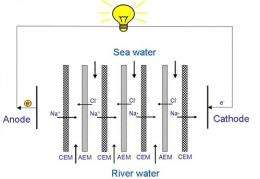Boosting the amount of energy obtained from water

The energy generated in places where fresh water and salt water meet is known as blue energy. This is a relatively new but highly promising renewable energy source. Piotr Długołęcki of the University of Twente and the Wetsus centre of excellence for sustainable water technology has further refined the method that is most commonly used to generate blue energy in the Netherlands. This method produces three to four times as much energy as previous processes.
Blue energy is a promising source of renewable energy. It is generated in places where fresh water and salt water meet, for example where rivers flow into the sea. Energy is generated by the difference between the salt content of fresh water and that of salt water.
When you dissolve salt in water, it splits into charged particles (ions). Half of these ions carry a positive charge, while the other half are negatively charged. Salt water therefore contains many more charged particles than fresh water, and you can use this difference to generate electricity. One method involves the use of special membranes, which selectively allow either positively or negatively charged particles to pass through. This results in a difference in charge across the membranes, which can be converted into electricity.
This process is known as reverse electrodialysis. Up to 5,000 membranes - each with an area of several square metres - can be set up in a sequential array. In the course of his research into this form of blue energy, Piotr Długołęcki of the University of Twente attempted to optimize the energy yield by focusing specifically on the transport of ions. His improvements have at least doubled, and possibly tripled, the energy output. Piotr carried out his research at Wetsus, a centre of excellence for sustainable water technology.
Shadow effect
Fresh water and salt water flow through the spaces between the membranes. At the interface between the salt water and the membrane, charged particles (ions) pass out of the water and into the membrane. They are then transported through the membrane, to the fresh water side. This takes place in what is known as the diffusion boundary layer. To maximize energy yields, it is vital that the water is well mixed and that it flows smoothly past the membranes. To this end, and to create turbulence in the diffusion boundary layer, mesh-like 'spacers' are inserted into the space between two adjoining membranes. One drawback of using the currently available, standard spacers is that they are unable to transport charged particles.
Accordingly, the part of the membrane that is covered by the spacer cannot be used to generate energy, which results in a lower energy yield. As a result of this 'shadow effect', the effective surface area of membrane available for the production of energy is less than the total area of the membrane.
Piotr Długołęcki investigated ways of minimizing these effects, and of generating the maximum amount of energy from the mixing of seawater and river water. He developed conductive spacers, doubling energy yields at a stroke. He then redoubled the energy yield, by improving the mixing and flow of water along the membranes.
Długołęcki's doctoral defence took place on Wednesday 18 November at the Faculty of Science and Technology.
Provided by University of Twente (news : web)


















